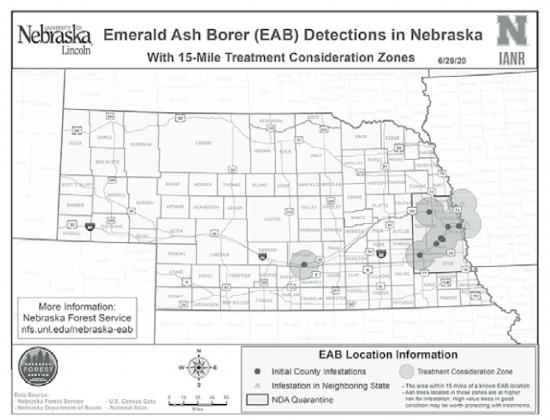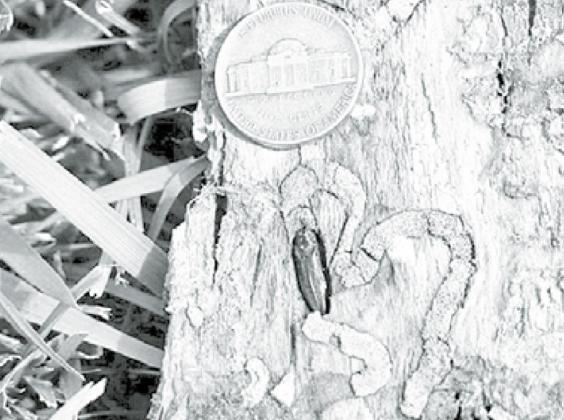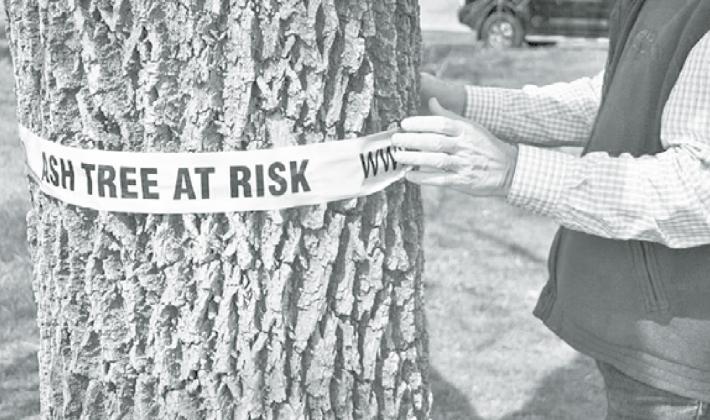■ Ben McEndarfer shares what to look for in troubled trees
In 2002 the emerald ash borer (EAB), a beetle native to Asia was find in Detroit, Mich. Since then it has spread to 25 states including Nebraska. Most recently this invasive species was found in Kearney.
The Nebraska Forest Service noted that EAB has destroyed tens of millions of true ash species and that around 44 million Nebraska ash trees will be lost in the coming years.
They reported that leaning EAB researchers speculate that the borer has the potential to “functionally” wipe out the ash species.
Adult EAB are green beetles approximately one-half inch long with slender bodies. Larvae are cream colored and up to 1-1/4 inch long. Larvae have brown heads and a 10-segmented body with bell-shaped segments near the back end.
The Nebraska Department of Agriculture announced recently that the EAB was found in Kearney. A severely declining street tree located near Pioneer Park was determined to be infested with the insect. This detection adds Buffalo County to the growing list of Nebraska counties with known EAB infestations.
“Emerald ash borer is considered to be one of the most destructive insect pest of trees ever to occur in the U.S.,” said Laurie Stepanek, forest health specialist with the Nebraska Forest Service. “Its impact on urban trees, native forests and windbreaks in Nebraska will surpass that of Dutch elm disease.”
The NDOA projected that Nebraska’s taxpayers and homeowners will ultimately spend over $961 million on ash tree removal, disposal and replacement due to this pest.
EAB is named for the bright metallic green color of the adult beetles. It is the immature stage, however, that causes the most damage to trees.
“The immature stage, or larva, tunnels into the trunk and branches, cutting off the flow of water, nutrients and sugars under the bark,” said Stepanek. “At the height of an EAB infestation, trees can die in a just a few years.”
Ben McEndarfer, owner of McEndafer Tree Services in Aurora, noted that infected trees will have dieback to the canopy.
“There will be new growth at the bottom of the tree as it tries to recover from the damage,” he described. “When the adults exit the tree they leaves a ‘D’ shaped hole that is flat on one side and round on the other.
The Nebraska Forest Service (NFS) also found that people can see bark stripping from woodpecker activity and zigzag tunnels under the bark.
Once a tree has been infected, McEndarfer noted that there are two options -- treatment or removal.
“If it’s a young, healthy tree it can be treated,” he said. “Older or damaged trees would be better removed before they die. Trees with EAB become brittle causing them to be dangerous and difficult and costly to remove.”
Trees left untreated will eventually die from EAB and will need to be removed. Community Forestry Specialist Graham Herbst recommended pre-emptive removal of living ash trees when possible.
“Trees that have died from EAB are extremely brittle and pose a hazard -- dropping limbs on people, buildings and cars,” Herbst explained. “There may also be a high demand for tree removals when large numbers of ash begin dying -- increasing prices and the chance that homeowners will be approached by ‘fly-by-night’ tree companies that may not have proper insurance, licensing, or training to remove hazardous trees.”
The other option which is encouraged for any tree that is in a 15-mile area of an infected tree is treatment.
“Treatments must be done for the remainder of the tree’s lifespan, therefore, take time to assess the value and health of your trees to determine if they are good candidates for treatment,” Stepanek said. “Trees worth treating are those that provide much-needed shade, are key components of the landscape or have intrinsic value. The trees should also be in very good condition with robust canopies, no large dead or dying branches and no mower damage or other serious trunk wounds.”
McEndarfer added that people who suspect an EAB infection shouldn’t treat or remove the tree right away as both options can be costly and there are many insects that can cause similar damage.
“There are a lot of native borers that resemble EAB,” he explained. “If you think you have an infection contact the Nebraska Forest Service and they’ll have someone check it out.”
While EAB has been found in neighboring states of Iowa, Missouri, Kansas and Colorado it has also made its way to Douglas, Cass, Lancaster, Saunders and Dodge counties. The borer is not quick moving on its own.
“EAB moves about a half mile a year,” he said. “They mostly move through accidental, human transportation in pallets or firewood especially through the I-80 corridor.”
The NFS encourages that to help slow the spread of EAB and other wood-infesting pests to collect and purchase firewood where it will be burned.
As many people are faced with the removal of infected or weakened tress, McEndarfer advised that they seek to replace them with a wide diversity of other trees.
“When Dutch elm disease came through everyone replaced them with ash trees,” he voiced. “Now we’re seeing it all over again with them.”
Though he hopes that not everyone will immediately remove a tree that he has seen all over the county and that some will choose treatment if an infection were to come to the area.
When it comes to choosing a replacement, NFS advises that people avoid planting ash trees. While the tree has gained popularity for it’s use in landscaping, having more biodiversity will improve the overall health of a community forest.
More information about emerald ash borer and recommended trees for replacement can be found at nfs.unl.edu/ nebraska-eab.
‘If it’s a young, healthy tree it can be treated. Older or damaged trees would be better removed before they die.’
Ben McEndarfer, McEndarfer Tree Services







